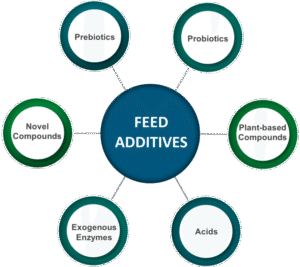Cell factories
Introduction
Feed enzymes, like other industrial enzymes, are currently produced on a large
scale mostly in submerged or deep-tank bioreactors. The production hosts are
microbial, either bacterial such as Bacillus spp. (B. subtilis, B. amyloliquefaciens
or B. licheniformis) or fi lamentous fungi, for example A. niger, A. oryzae, H.
insolens and T. reesei. The history of these hosts originates from their use in
the starch processing industry (Bacillus and Aspergillus), for detergent
protease (Bacillus) or for cellulase production (Trichoderma, Humicola).
These hosts naturally secrete a large array of enzymes, are non-pathogenic
and easy to cultivate on an industrial scale. Tools exist for genetic engineering
of all of these hosts, and representative genomes have been published for most
of them (Kunst et al., 1997; Veith et al., 2004; Machida et al., 2005; Pel et
al., 2007; Martinez et al., 2008). Intellectual property rights (IPR) protecting
DNA transformation, use of certain strong promoters and heterologous or
fusion protein production may still block commercial exploitation of gene
technology in certain hosts and in certain countries, particularly in the USA,
where the patent term used to be 17 years from the grant rather than from the
fi ling date.
New recombinant fungal hosts have recently been developed, e.g.
Chrysosporium lucknowense (or C1) by Dyadic International, Inc., with the
apparent benefi t of a wider range of cultivation temperatures and pH options
and favourable morphology (Gusakov et al., 2007). The methylotrophic yeast
Pichia pastoris is also available for both research and commercial exploitation
from Invitrogen Corporation (http://www.invitrogen.com) and Research
Corporation Technologies (http://www.rctech.com), for organizations and
companies that have no access to other proprietary production platforms
(Teng et al., 2007).
Thank you for reading. Don't forget to subscribe & share!









